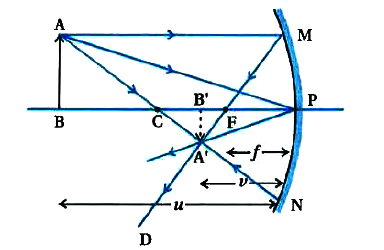Obtain the equation of power for combination of lenses.Solution in Gujrati
As power of lens is P=1f, equivalent power of combination,
P=P1+P2+P3+...
Note that it is an algebraic sum of individual powers.
So sum of the terms on the right side may be positive for convex lenses and negative for concave lenses.
Combination of lenses helps to obtain diverging or converging lenses of desired magnification. It also enhances sharpness of the image.
Combination of lenses is used in camera, microscope, telescope and other optical instruments.
Topper's Solved these Questions
- RAY OPTICS AND OPTICAL INSTRUMENTSBOOK - KUMAR PRAKASHANCHAPTER - RAY OPTICS AND OPTICAL INSTRUMENTSEXERCISE - SECTION - A (TRY YOURSELF)
74 Videos
- RAY OPTICS AND OPTICAL INSTRUMENTSBOOK - KUMAR PRAKASHANCHAPTER - RAY OPTICS AND OPTICAL INSTRUMENTSEXERCISE - SECTION-B (NUMERICALS)(NUMERICAL FROM TEXTUAL ILLUSTRATIONS)
17 Videos
- MOVING CHARGES AND MAGNETISMBOOK - KUMAR PRAKASHANCHAPTER - MOVING CHARGES AND MAGNETISMEXERCISE - SECTION D (MCQs ASKED IN COMPETITIVE EXAMS)
34 Videos
- SAMPLE QUESTION PAPER BOOK - KUMAR PRAKASHANCHAPTER - SAMPLE QUESTION PAPER EXERCISE - PART-B SECTION-C
5 Videos
Similar Questions
Give range of wavelength of visible light.
View SolutionSuppose that the lower half of the concave mirror.s reflecting surface as shown in figure is covered with an opaque (non-reflective) material. What effect will this have on the image of an object placed in front of the mirror ?

View SolutionElectric charge Q having mass M moves on a circular path of radius R with velocity →v, perpendicular to uniform magnetic field B. When a particle completes one revolution, work done by the field is _______
View SolutionTwo charges –q and +q are located at points (0, 0, –a) and (0, 0, a), respectively.
(a) What is the electrostatic potential at the points (0, 0, z) and (x, y, 0) ?
(b) Obtain the dependence of potential on the distance r of a point from the origin when r/a>>1 .
(c) How much work is done in moving a small test charge from the point (5,0,0) to (–7,0,0) along the x-axis? Does the answer change if the path of the test charge between the same points is not along the x-axis?
View SolutionTwo convex lenses of the same material and power + 10D and + 12.5D are available. How will you arrange them to obtain an achromatic combination and what will be the power of the combination?
View Solutionदो लेंस जिनकी शक्तियां 4D और -2D है, संपर्क में रखे है! संयुक्त लेंस की शक्ति होगी-
View SolutionObtain an expression for the combined focal length for two thin convex lenses kept in contact and hence obtain an expression for the combined power of the combination of the lenses.
View Solution25 सेमी की समान फोकस दूरी के उत्तल और अवतल लेंसो को जोडकर प्राप्त लेंस स संयेाजन की शक्ति डाइऑप्टर में होगी-
View Solutionलेंस की शक्ति की परिभाषा लिखिए । संपर्क में रखे दो पतले लैंसों के संयोजन के प्राप्त संयुक्त लेंस की परिणामी शक्ति के लिए सूत्र व्युत्पत्र कीजिए। किरण चित्र बनाइए।
View Solution(i) A convex lens of power +6D and a concave lens of power -4D are combined together. Find the power of the combination of two lenses.
View Solutionलेन्सों का अवर्णक संयोजन निम्नलिखित को जोड़ने से प्राप्त होता है
View SolutionObtain the equation of magnification of combination of lenses.
View SolutionThe power of combination of two lenses o powers + 1.5 D and - 2.5 D is .......
View SolutionGive the formula for calculating the power of combination of two lenses.
View SolutionTo obtain an achromatic combination using the lenses of same material the two lenses should be :
View Solution
